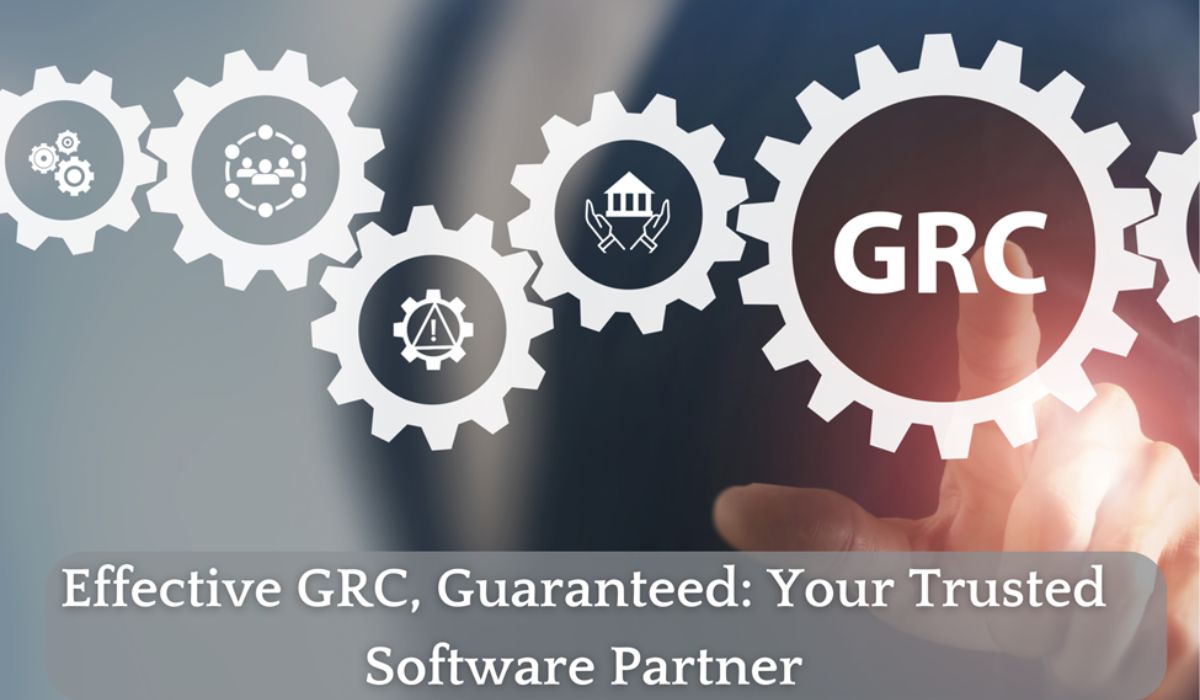TECHNOLOGY
Effective GRC, Guaranteed: Your Trusted Software Partner

Ready to tame the complexities of regulatory compliance and risk management once and for all? In today’s rapidly evolving business environment, keeping up with regulations while managing risks can feel like a full-time job, and one mistake could be costly. But what if there was a way to stay ahead, minimize risks, and cut compliance costs by up to 30%?
That’s where GRC software comes in. With the right solution, you can transform your governance, risk, and compliance processes, making them not only manageable but a strategic advantage. Ready to see how? Let’s dive into how GRC can guarantee your success in a world of uncertainty.
Navigating the GRC Landscape with Precision
GRC software has become an indispensable tool for organizations seeking to streamline their governance, risk management, and compliance processes. By providing real-time insights and automating critical functions, GRC software offers a range of benefits that can significantly impact an organization’s bottom line and operational efficiency.
Implementing GRC software offers significant benefits for organizations by reducing compliance-related costs through automation, which minimizes manual tasks and errors. GRC software enhances risk visibility, enabling businesses to proactively identify and address potential threats, leading to stronger risk management strategies.
Moreover, GRC software simplifies compliance processes, helping organizations stay on top of regulatory requirements with ease. This combination of automation, improved risk oversight, and efficient compliance tracking ensures that businesses operate more effectively while mitigating potential risks.
Identifying the Key Features of High-Performance GRC Solutions
To truly maximize the benefits of GRC software, it’s crucial to choose a solution that offers key features designed for high performance. Let’s explore some of the essential components that set top-tier GRC software apart:
- Real-time ability for risk assessment to respond promptly against threats.
- It simplifies processes by providing integrated tracking of compliance.
- Automation of reporting reduces the possibility of errors and ensures timely compliance.
- Customizable dashboards enhance decision-making.
- Scalable solutions grow to meet your ever-growing business needs.
Examples of Successful Customization in GRC Implementations
GRC solutions are great, but their potent functionality can only be fully realized when the software has been customized. Performance and risk management become much more efficient when GRC software is tailored to handle specific organizational risks and compliance requirements. The alignment of the software with business processes, industry regulations, and internal policies provides the ability to manage the most critical challenges.
A tailored GRC solution is not a one-size-fits-all approach; it is customized to meet the specific needs of each business. This helps organizations manage risks with greater efficiency and ensures compliance processes are streamlined for better outcomes.
Integration Strategies for Seamless GRC Implementation
To fully harness the power of GRC software, organizations must ensure seamless integration with their existing enterprise systems. This integration is crucial for creating a unified view of governance, risk, and compliance across the entire organization.
Effective integration strategies typically involve:
- Data mapping: Identifying and mapping data sources from various systems to the GRC platform.
- API utilization: Leveraging application programming interfaces (APIs) to facilitate smooth data exchange between systems.
- Process alignment: Aligning GRC processes with existing workflows to minimize disruption.
Overcoming Integration Challenges
While integration does come with its own set of challenges, facing them is key to GRC’s success. Some common challenges faced by people are:
- Data silos: breaking down data silos to make sure comprehensive risk and compliance visibility is assured.
- Legacy systems: This would involve devising ways of integrating with rather older, less compatible systems.
- User adoption: This is where proper training and support are given for the smooth adoption of the integrated GRC solution.
It identifies these challenges and proactively takes action to mitigate their individual effects, allowing organizations to bring forth a unified ecosystem that can create operational efficiency and effectiveness in all respects.
Ensuring Compliance and Mitigating Risks with Advanced GRC Features
Modern GRC software often incorporates advanced analytics capabilities, allowing organizations to gain deeper insights into their risk landscape. These analytics tools can:
- Identify patterns and trends within risk data.
- Anticipate and predict compliance issues before they happen in the first place.
- Provide actionable insights on risk mitigation strategies.
These advanced capabilities enable organizations to move toward proactive risk management by staying one step ahead of potential threats and compliance challenges.
Automated Compliance Monitoring and Reporting
Automation is a game-changer in the realm of compliance management. GRC software with robust automation features can:
- Continuously monitor the compliance status of diverse regulations.
- Develop real-time alerts for potential compliance breaches
- Produce comprehensive compliance reports with least manual input.
This level of automation not only takes a lot of heat off the compliance teams’ backs but also greatly enhances the accuracy and timeliness of compliance reporting.
Evaluating and Choosing the Right GRC Software Partner
Selecting the right GRC (Governance, Risk, and Compliance) software partner is essential for ensuring long-term success and effective management of your organization’s governance, risk, and compliance processes.
Here are key factors to consider when evaluating potential partners:

Measuring Success
Establishing and monitoring key performance indicators will help ensure your GRC software continues to deliver value.
Certain KPIs in this regard are:
- Cost reduction due to higher compliances
- Improvement in risk identification and mitigation
- Reduction in audit findings
- Time saved on reporting for compliance
Continuous Improvement and Feedback Loops
Successful GRC implementation is a continuous process. Establish the loops for feedback and mechanisms for continuous improvement so that your GRC solution will grow along with the needs of your organization and the currently changing regulatory landscape.
Conclusion
Proper implementation of GRC software can transform how an organization manages governance, risk, and compliance. With due consideration for features, customization options, strategies for integrations, and vendor support, a company is guaranteed to have successful GRC implementation, assuring real value and fostering overall efficiency in operations.
As you embark on your GRC journey, remember that the right software partner is key to effective governance, risk management, and compliance.
FAQs
- What factors should be considered when customizing GRC software to fit an organization’s needs?
When customizing GRC software, it’s important to consider factors such as the specific regulatory requirements relevant to your industry, internal risk management processes, and existing IT infrastructure. Customization should align with your organization’s unique workflows and compliance needs. Engage with stakeholders from different departments to understand their needs and ensure that the customization supports both operational efficiency and regulatory adherence.
- How can organizations measure the effectiveness of their GRC software after implementation?
To measure the effectiveness of GRC software, organizations should track key performance indicators such as improvements in compliance audit scores, reductions in compliance-related costs, and enhanced risk identification and mitigation. Regularly review and compare these metrics against pre-implementation benchmarks to assess the software’s impact. Additionally, gather feedback from users to ensure that the system meets their needs and integrates well with existing processes.
- What are the best practices for training employees on a newly implemented GRC system?
Effective training for a new GRC system involves a combination of comprehensive onboarding sessions, hands-on practice, and ongoing support. Start with an overview of the system’s features and benefits, followed by detailed training on how to use specific functionalities. Provide practical exercises that simulate real-world scenarios. Establish a support system for questions and troubleshooting, and offer refresher courses as needed to keep employees up-to-date with any system updates or changes.
APPS & SOFTWARE
How To Manage Employees at Scale: Workforce Management Software

Companies that maintain a clear record of employee time, attendance, and tasks may experience boosted performance and improved bottom lines. Workforce management software enables labor-intensive organizations to maximize labor efficiency, minimize compliance risks, and develop strategic insight that improves business operations. Embracing a data-driven approach to management helps companies retain talent, cut labor costs, and adhere to labor laws. Here are a few ways workforce software can help you manage employees at scale:
Improved Labor Optimization
Management software identifies and alerts management to labor issues such as overstaffing or understaffing based on forecasted workloads. Workforce management software analyses historical data and business trends to align staff schedules with anticipated demand. It factors employee availabilities, skills, and preferences to generate optimized schedules that result in better timekeeping and adherence to deadlines. Businesses may experience reduced scheduling errors, optimized workforce utilization, smoother shift planning, and improved employee satisfaction due to fair and balanced schedules. Labor optimization increases productivity and success rates as each task is assigned and complies with the company’s workflow.
Enhanced Demand Forecasting
Accurately forecasting demand for a large and dispersed workforce, including remote employees, can present significant growth and operational efficiency opportunities. Miscalculated labor requirements lead to inefficient staffing that strains the budget and interferes with performance. A workforce management system uses artificial intelligence algorithms to predict workload volume for active operation days. The forecasted data can help management make informed decisions on when to increase or scale down the workforce. The software uses repeated data patterns to forecast future requirements, helping businesses to have better budget and resource allocation planning.
Automated Scheduling
Manual schedule creation is time-consuming for a large workforce, especially when different shifts and employee skills are involved. Workforce management systems are automated and generate schedules that align with forecasted demand, employee availability, and skill sets. Such systems allow for easy updating and making changes to the schedule. A workforce management tool features workforce sharing, smart templates, and shift swapping. It will enable staff to pick up open shifts or make changes that a supervisor approves. Automated scheduling streamlines administrative tasks and promotes equitable distribution of shifts.
Improved Time Tracking and Attendance
Employee attendance and time tracking help calculate the number of hours worked, overtime, and absences. Managing data tracking manually for a large workforce can pose challenges in terms of time consumption, error risks, and complexity. Workforce management software provides a more efficient solution by automating the time-tracking process. Employees clock in and out using their devices, eliminating discrepancies or manual calculations. This feature also helps managers better understand their employees’ productivity and identify any issues that may arise.
Improved Compliance and Reporting
Compliance with labor laws and regulations is a requirement for any organization. The laws stipulate maximum working hours, minimum wage, and overtime pay. Employees are entitled to rest, meal breaks, and a set number of vacation days. A workforce software ushers in automation and standardization, promoting law adherence. The software also generates comprehensive reports on employee data. The report makes it easier for organizations to monitor compliance and identify any areas of improvement. These reports can also aid in identifying trends and patterns within the workforce, enabling organizations to make proactive changes.
Enhanced Employee Engagement
Features in a workforce management system, including newsfeeds, polls, surveys, and scheduling communications, support effective information sharing across the organization. Highly engaged employees are more productive, have lower absenteeism rates, and stay with the company longer. Workforce management tools improve employee engagement in various ways. The software allows employees to view their schedules and adjust as needed, promoting transparency and control over their work hours. It provides a platform for employees to request time off, swap shifts with colleagues, and communicate with managers. This level of autonomy and communication fosters a sense of ownership and teamwork among employees. The software can track employee performance and provide top performers, further boosting engagement levels.
Maximize Efficiency With Workforce Management Software
Effective communication improves workplace efficiency and reduces errors. Workforce management software allows for streamlined communication between employees, managers, and HR personnel. The software sends automated notifications, reminders, and updates to keep everyone on the same page. It also provides a centralized platform for all employee information, eliminating the need for multiple manual systems. Investing in workforce software may lead to significant cost savings and improve organizational success. Implement workforce software into your business processes today.
GADGETS
Choosing the Right Driveway Bollards for Your Home: Factors to Consider

In every homeowner’s journey, there are selections and decisions to make that significantly impact the safety and aesthetics of the home. One such vital choice is selecting the appropriate driveway bollards. These security structures are increasingly becoming a commonplace in residential driveways. They provide safety, deter theft, enhance aesthetic appeal, and contribute to the overall value of your home.
Key Factors to Consider
Here, we are going to dig deep into several factors you need to consider getting the right driveway bollards.
1. Material
The choice of material for your driveway bollards plays a critical part in their durability, maintenance needs, and overall look. Popular materials include steel, stainless steel, aluminium, and concrete, each with its advantages and functionality.
2. Functionality
Driveway bollards can either be decorative or functional, or both. Functional bollards are usually stronger and are designed to resist vehicle impact, while decorative bollards enhance the visual appearance of your property. Consider your priorities before making a choice.
3. Design and Aesthetic Appeal
The design of your bollards ought to blend with the overall theme of your home. A mismatch could disrupt the aesthetic balance of your property. The colours, styles, and finishes are all important elements that will help ensure your bollards are in harmony with your home’s aesthetic.
4. Size and Placement
The size of your bollards and their placement determine their effectiveness in securing your property. For maximum barrier protection, ensure the bollards are placed strategically at your driveway’s entrance and exit points.
In Conclusion
Choosing the right driveway bollards requires thoughtful consideration of the aforementioned factors. Material, functionality, design, aesthetic appeal, size, and placement all are crucial elements that should be considered. It’s also worth noting that while bollards significantly enhance security, they should not interfere with the normal functionality of your driveway. A well-chosen set of bollards can be a great asset to your home, adding both practicality and aesthetic value. So take your time, do your research, consider the factors mentioned in this article, and you’re likely to come away with bollards that are fit for purpose, durable, and pleasing to the eye.
TECHNOLOGY
Best Practices for NEMT Providers: Safety, Reliability, and Compliance

In the healthcare industry, the role of non-emergency medical transportation (NEMT) services continues to become more critical.
These vital services bridge the gap between patients and their necessary medical appointments, ensuring that lack of transportation is never a barrier to healthcare access.
While availability is the heart of effective NEMT service, its foundational pillars are safety, reliability, and compliance. Each of these elements plays a crucial role in meeting and exceeding the expectations of patients and healthcare providers alike.
This article examines these ideals and how NEMT operators can effectively reinforce them in their businesses.
Ensuring Safety in NEMT Services
Safety is essential to any transportation service, especially in NEMT. Below are several ways to guarantee safety in your business.
Ensuring Vehicle Safety
NEMT vehicles must comply with safety standards and undergo regular maintenance checks to guarantee passenger safety.
This includes the mechanical integrity of the vehicles, ensuring each one is equipped to meet patients’ needs with the essential medical and accessibility equipment.
Driver Safety Training
Safety on the road transcends basic driving skills.
NEMT drivers must undergo comprehensive training covering safe driving practices, emergency response, and the unique needs of patients transported. This training should be ongoing, ensuring drivers remain at the forefront of safety and service excellence.
Patient Safety Measures
The well-being of patients during transport is a top priority.
Implementing rigorous health and hygiene protocols is essential, especially in today’s environment. Drivers must be trained in safe patient handling techniques to prevent falls and injuries and ensure patients’ secure and comfortable journeys.
Ensuring Reliability in NEMT Services
Proving to clients that you are trustworthy by delivering on your promises is crucial to the reputation and well-being of any NEMT business. Here are several ways to ensure your services are effective and reliable.
Efficient Dispatch Systems
At the center of a reliable NEMT service is a well-designed dispatch system.
Leveraging advanced software solutions enables efficient scheduling, route optimization, and real-time tracking for timely services.
Communication Protocols
Clear, open lines of communication with patients and healthcare providers form the bedrock of reliability.
This includes confirming appointments, providing updates on arrival times, and establishing a direct channel for feedback and concerns.
Contingency Planning
Unexpected events are part of the transportation world.
Having robust contingency plans in place for vehicle breakdowns, driver unavailability, or unforeseen delays ensures that the service remains reliable, even in the face of challenges.
Upholding Compliance in NEMT Services
While they may differ depending on state or region, every NEMT provider must comply with specific regulations from various entities.
Adhering to Regulations
Compliance with local, state, and federal regulations is non-negotiable.
NEMT providers must stay informed about the regulatory landscape and ensure that all aspects of their operation, from vehicle standards to driver qualifications, meet or exceed these requirements.
Medicaid Compliance
For many NEMT providers, Medicaid is a significant source of patient referrals and funding.
Navigating the complexities of Medicaid compliance, from understanding eligibility requirements to proper billing practices, is essential for operational success and integrity.
Data Security and Privacy
Protecting patient information is not just a matter of compliance; it’s a matter of trust.
Implementing stringent data security measures and ensuring compliance with HIPAA guidelines are critical in safeguarding patient privacy and securing sensitive information.
Continuous Improvement and Quality Assurance
The commitment to excellence in NEMT services is an ongoing journey.
Regular monitoring, patient feedback mechanisms, and quality assurance audits are essential in identifying improvement areas and ensuring the highest service standards are maintained.
Conclusion
Safety, reliability, and compliance are not NEMT buzzwords. These foundational principles help build successful services.
By following these best practices, NEMT providers can ensure they offer services that are needed and valued by the patients and communities they serve. In doing so, they contribute to the broader healthcare ecosystem and stand out as providers of choice in a competitive industry.

 ENTERTAINMENT5 days ago
ENTERTAINMENT5 days agoExploring the Kristen Archives: A Treasure Trove of Erotica and More

 ENTERTAINMENT1 day ago
ENTERTAINMENT1 day agoKiss KH: The Streaming Platform Redefining Digital Engagement and Cultural Currents

 TECHNOLOGY4 months ago
TECHNOLOGY4 months agoBlog Arcy Art: Where Architecture Meets Art

 LIFESTYLE4 months ago
LIFESTYLE4 months agoThe Disciplinary Wives Club: Spanking for Love, Not Punishment

 EDUCATION1 day ago
EDUCATION1 day agoLingrohub Platform: A Complete Student Access Guide

 ENTERTAINMENT3 weeks ago
ENTERTAINMENT3 weeks agoMonkeyGG2: Your Personal Gaming Hub

 TECHNOLOGY4 days ago
TECHNOLOGY4 days agoOurDream.ai Review: The Generative Art Engine Rewiring Imagination

 TECHNOLOGY1 day ago
TECHNOLOGY1 day agoCasibom: The Digital Alchemy Reshaping Systems, Society, and Self










